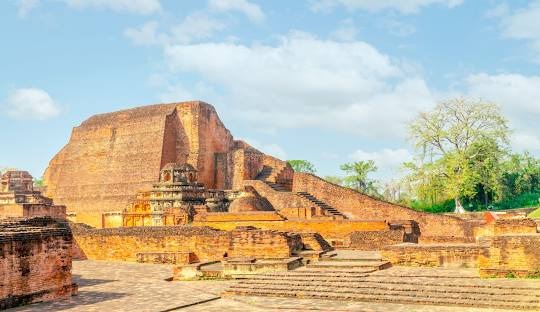Two ancient Indian institutions, Takshashila and Nalanda, set the foundations for global higher education centuries before the establishment of renowned Western universities. These centers of learning attracted scholars from across Asia, fostering a rich environment of intellectual exchange and innovation that shaped the course of human knowledge.
This article delves into the captivating stories of Nalanda and Takshashila, exploring their origins, the vast knowledge they imparted, the factors that led to their decline, and its enduring impact as a symbol of excellent education in ancient India.
Takshashila, located in modern-day Pakistan, flourished as a center of learning from the 6th century BCE to the 5th century CE. Its strategic position at the crossroads of major trade routes made it a melting pot of cultures, attracting students and scholars from Persia, Greece, and beyond. The institution offered a diverse curriculum including medicine, mathematics, astronomy, and statecraft. Takshashila’s cosmopolitan atmosphere fostered a unique academic environment where students could learn from a wide range of perspectives.
Takshashila’s significance is rooted in its strategic location on the trade routes that connected the Indian subcontinent with Central Asia and the Mediterranean. This made it a melting pot of cultures, ideas, and knowledge.
Takshashila was influenced by a powerful Persian empire in the 500s BC. Later, in 326 BC, Alexander the Great conquered it. But even after that, the city continued to thrive under various rulers, including the Maurya and Kushan empires.
Nalanda, founded in 427 CE in the ancient kingdom of Magadha (modern-day Bihar, India), took the torch from Takshashila and burned brightly for over 800 years. Established by “Emperor Kumaragupta I” of the Gupta Empire, Nalanda grew to become the world’s first residential university, predating Oxford and Bologna by more than five centuries.
At its peak, Nalanda boasted an impressive faculty of 2,000 teachers and a student body of 10,000. The institution’s reputation for excellence attracted scholars from China, Korea, Japan, Tibet, Mongolia, and Southeast Asia. Chinese pilgrim Xuanzang, who studied at Nalanda in the 7th century CE, described it as a place where “the professors were all men of high ability and talent…firmly grounded in the principles of their religion.”
Nalanda’s curriculum was comprehensive, covering Buddhist philosophy, logic, metaphysics, medicine, astronomy, and mathematics. The institution’s approach to learning emphasized debate and discourse, creating a vibrant intellectual environment that fostered critical thinking and innovation.
Nalanda met a tragic end, but its legacy lives on. The ruins stand today as a powerful symbol of India’s rich intellectual heritage, and a modern university established near the ruins aims to revive the spirit of the ancient center of learning.
Both Takshashila and Nalanda boasted impressive libraries. Nalanda’s library, housed in a nine-story building, contained millions of manuscripts, making it one of the richest repositories of Buddhist wisdom in the world. Similarly, Takshashila’s extensive collection of texts played a crucial role in preserving and disseminating knowledge across ancient Asia.
The decline of these great institutions came through different circumstances. Takshashila’s influence waned due to political instability and the rise of other centers of learning. Nalanda met a more tragic end, destroyed around 1200 CE during a raid by Muhammad Bakhtiyar Khilji.
Despite their eventual demise, the impact of Takshashila and Nalanda on global education and intellectual development cannot be overstated. Notable alumni from these institutions, such as the grammarian Panini, the physician Charaka, and the political strategist Kautilya (Chanakya), made significant contributions to their respective fields, shaping the course of human knowledge. These historic universities have inspired generations of people.
Nalanda and Takshashila’s stories remind us of the importance of intellectual exchange, open inquiry, and cultivating well-rounded individuals. As we strive to build better educational systems, the spirit of these ancient seats of learning continues to guide us.
In 2010, the Indian government established a new Nalanda University near the ancient ruins, dedicated to promoting peace and interfaith understanding. The institution aims to revive the spirit of the ancient center of learning and foster international collaboration in education.
The story of Takshashila and Nalanda serves as a powerful reminder of India’s rich intellectual heritage and its significant contributions to global education. As modern educational institutions grapple with the challenges of globalization and rapid technological change, the enduring legacy of these ancient seats of learning offers valuable lessons in fostering innovation, promoting cross-cultural understanding, and nurturing a truly global perspective on knowledge and learning.









![[L-R] WW1 Victoria Cross recipient Khudadad Khan, Rifleman Gabar Singh Negi and Lance-Daffadar Gobind Singh.](https://link4din.com/guardians-numeric-wisdom/wp-content/uploads/2025/02/Untitled-design-4-220x134.webp)